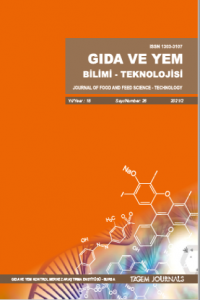Helix pomatia' DAN İŞLENEN SALYANGOZ DOLMASININ MİKROBİYOLOJİK KALİTESİ
Çalışma önemli bir ihraç ürünü olan salyangoz dolmasının mikrobiyolojik kalitesini belirlemek amacıyla yapılmıştır. Çalışmada, 10 adet çiğ salyangoz, 30’ar adet dondurulmuşsalyangoz eti ve salyangoz dolması, aerobik mezofilik bakteri, koliform bakteri'er, Escherichia coli, koagülaz pozitif stafilokoklar, Salmonella spp. ve Listeria spp. yönünde ı incelenmiştir. Çalışma sonucunda hammaddenin yoğun mikrobiyolojik yüküne rağmen işlem >asamaklarınınmikrobiyolojik kaliteyi olumlu yönde etkilediği görülmüştür. Salyangoz dolme sında, aerobik mezofilik bakteri 30 örnekte de 103 kob/g seviyesinde, koliform bakteriler 3 örnekte 4, birörnekte 6, bir örnekte de 240 EMS/ g düzeyinde bulunmuştur. Bu değerler, aerobik mezofilik bakteri sayısı bakımından gerek EEC 93/493, 93/51’nin gerekse Tarım ve Köy İşleriBakanlığı’nın belirlediği değerlerin altındadır. Bir örnekteki koliform bakterilerin sayısı Tarım ve Köy İşleri Bakanlığı’nın belirlediği değerlerin (160-210 EMS/ g) üstündedir. Sonuç olarak işlem basamakları mikrobiyolojik kaliteyi olumlu yönde etkilemesine rağmen, işletme hijyeninden kaynaklanabilecek mikrobiyolojik kontaminasyonların önlenebilmesi için, kritikkontrol noktalarının belirlenmesi ve HACCP sisteminin etkin bir şekilde uygulanması gerekmektedir.Anahtar Kelimeler: Helix pomatia, salyangoz dolması, mikrobiyolojik kalite
Anahtar Kelimeler:
-
___
- ANDREVVS, W. 1992. Manual of Food Ouality Control 4, Microbiological Analysis (Rev. 1).
- VVashington, DC: FAO C o n su lta n t, Food and Drug A dm in is tra tio n .
- ANONYMOUS. 1983. Gıda Maddeleri Muayene ve Analiz Yöntemleri Kitabı. Tarım Orman
- ve Köy İşleri Bakanlığı, Gıda İşleri Genel Müdürlüğü. Genel Yayın No: 65, Ankara,
- -607.
- ANONYMOUS. 2000. Su Ürünleri Kalite Kontrol El Kitabı. Tarım ve Köyişleri Bakanlığı,
- Koruma ve Kontrol Genel Müdürlüğü. Ankara, 198.
- ANONYMOUS. 2000. Official Methods of Analysis of AOAC International. 17 th
- Edition. Vol 1, 78-80.
- CROCI L., L. SUFFREDINI, L. COZZI and L. TOTI. 2002. Effects of Depuration of Molluscs
- Experimentally Contaminated with Escherichia coli, Vibrio cholerae 01 and Vibrio
- parahabrrolyticus. J. Appl. Microbiol., 92, 460-465.
- DORE J.V., M. MACKIE and D.N. LEES. 2003. Levels of Male-spesific RNA Bacteriophage
- and Escherichia coli in Molluscan Bivalve Shellfish from Commercial Harvesting
- Areas. Lett. Appl.Microbiol., 36, 92-96.
- FORMIGA-CRUZ M., A.K. ALLARD, A.C. CONDEN-HANSSON, K. HENSHILLVVOOD, B.E.
- HERNROTH, J. JOFRE, D.N. LEES, F. LUCENA, M. PAPAPETROPOULOU, R.E.
- RANGDALE, A. TSIBOUXI, A. VANTARAKIS and R. GIRONES. 2003. Evaluation of
- Potential Indicators of Viral Contamination in Shellfish and Their Applicability to
- Diverse Geographical Areas. Ap pl. E n v iro n . M ic ro b io l., 69, 155 6-1563.
- GEARY P.M. and C.M. DAVIES. 2003. Bacterial Source Tracking and Shellfish Contamination
- in a Coastal Catchment. VVater Sci. Techn., 47, 95-100.
- GOMOT, A. 1998. Biochemical Composition of Helix Snails: Influence of Genetic and
- Physiological Factors. J. Molluscan Studies, 64, 173-181.
- GOULDING, I. 2002. From Catch the Counter, Keeping Track of Fish. Seafood International,
- June 17, 33-36.
- HARRIGAN W.F. and M.E. McCANCE. 1976. Laboratory Methods in Food and Dairy
- Microbiology. Academic Pres Ltd. London.
- HARRIGAN, W.F. 1998. Laboratory Methods in Food Microbiology. 3rd edition. Academic
- Press., 525 B Street, Süite 1900, San Diego, California, USA. ISBN: 0-12- 3260434.
- Hitchins, A. 1995. FDA Bacteriological Analytical Manuel, 8th Edition.
- HUSS, H.H. 1997. Control of Indigenous Pathogenic Bacteria in Seafood. Food Control, 8,
- -98.
- HUSS, H.H., A. REILLY and P.K.B. EMBAREK. 2000. Prevention and Control of Hazards
- in Seafood.Food Control, 11, 149-156.
- ICMSF. 1982. Microorganims in Foods. Their Significans and Methods of Enumeration. 2nd
- Ed. Univ.Toronto Pres. London.
- Lancette, G.A. and S.R. Tatini. 1992. Staphylococcus aureus. İn: Compendium of Methods
- for the Microbiological Examination of Foods. Ed.: Vanderzant, C., Splittstoesser.
- D.F. VVashington DC.: American Public Health Association.
- LIPP E.K. and J.B. ROSE. 1997. The Role of Seafood in Foodborne Diseases in the United
- States of America. Revue Scientifique et Technique de L Office International Des
- Epizooties, 2, 620-640.
- MIOSSEC L., F. Le GUYADER, D. PELLETIER, L. HAUGARREAU, M.P. CAPRAIS and M.
- POMMEPUY. 2001. Validity of Escherichia coli, Enterovirus and F-spesific RNA
- Bacteriophages as Indicators of Viral Shellfish Contamination. J. Shellfish
- Res., 20, 1223-1227.
- (2005) GIDA ve YEM BİLİMİ-TEKNOLOJİSİ 5ayı: 7
- MUNIAIN-MUJIKA I., M. CALVO, F. LUCENA and R. GIRONES. 2003. Comparative Analysis
- of Viral Pathogens and Potential Indicators in Shellfish. Int. J. Food Microbiol., 83,
- -85.
- PLUSQUELL.EC A., M. BEUCHER, C. LELAY, D. GUEGUEN and Y. LEGAL. 1994. Uptake
- and Retention of Salmonella by Bivalve Shellfish. J. Shellfish Res., 13, 221-227.
- STEINHARD C.E., M.E. DOYLE and B.A. COCHRANE. 1995. Food Safety: Foodborne
- Microbial lllness. Marcel Dekker Inc. New York, 519-521.
- TIAN Y.Q., P. GONG, J.D. RADKE and J. SCARBOROUGH. 2002. Spatial and Temporal
- Modeling of Microbial Contaminants on Grazing Farmlands. J. Environ. Qual., 31,
- -869.
- ÜNLÜTÜRK, A. ve F. TURANTAŞ. 1999. Gıda Mikrobiyolojisi. Mengi Tan B? sımevi. Çınarlı,
- İzmir, 522 s.
- YALÇIN, S., Y. DOĞRUER ve S. YALÇIN. 1995. Kara Salyangozu Etinin M krobiyolojik
- Kalitesi ve Kimyasal Bileşimi. Veterinarium, 6 (1-2): 50-52.
- ISSN: 1303-3107
- Yayın Aralığı: Yılda 2 Sayı
- Başlangıç: 2015
- Yayıncı: Bursa Gıda ve Yem Kontrol Merkez Araştırma Enstitüsü
Sayıdaki Diğer Makaleler
TRANS YAĞ ASİTLER! KAYNAKLARI VE İNSAN SAĞLIĞI ÜZERİNE ETKİLERİ
Mustafa KIRALAN, Aslı YORULMAZ, Hüdayi ERCOŞKUN
İmran KAYA, Aykut GÜLEREN, Nizamettin ÇALIŞKAN, İbrahim SARICA
İSTANBUL’DA SATIŞA SUNULAN İÇME SÜTÜ ÖRNEKLERİNDE AFLATOKSİN M1 DÜZEYLERİ ÜZERİNE BİR ARAŞTIRMA
Kamil BOSTAN, Ömer ÇETİN, Serkan BÜYÜKÜNAL, Özer ERGÜN
Helix pomatia' DAN İŞLENEN SALYANGOZ DOLMASININ MİKROBİYOLOJİK KALİTESİ
TOPLUM BESLENMESİNDE SÜT VE ÜRÜNLERİNİN YERİ VE ÖNEMİ
BAZI DONDURULMUŞ GIDALARDA MİKROBİYOLOJİK KALİTE
ISIYA DAYANIKLI KÜFLERİN GIDA SANAYİİ ve HALK SAĞLIĞI AÇISINDAN ÖNEMİ
